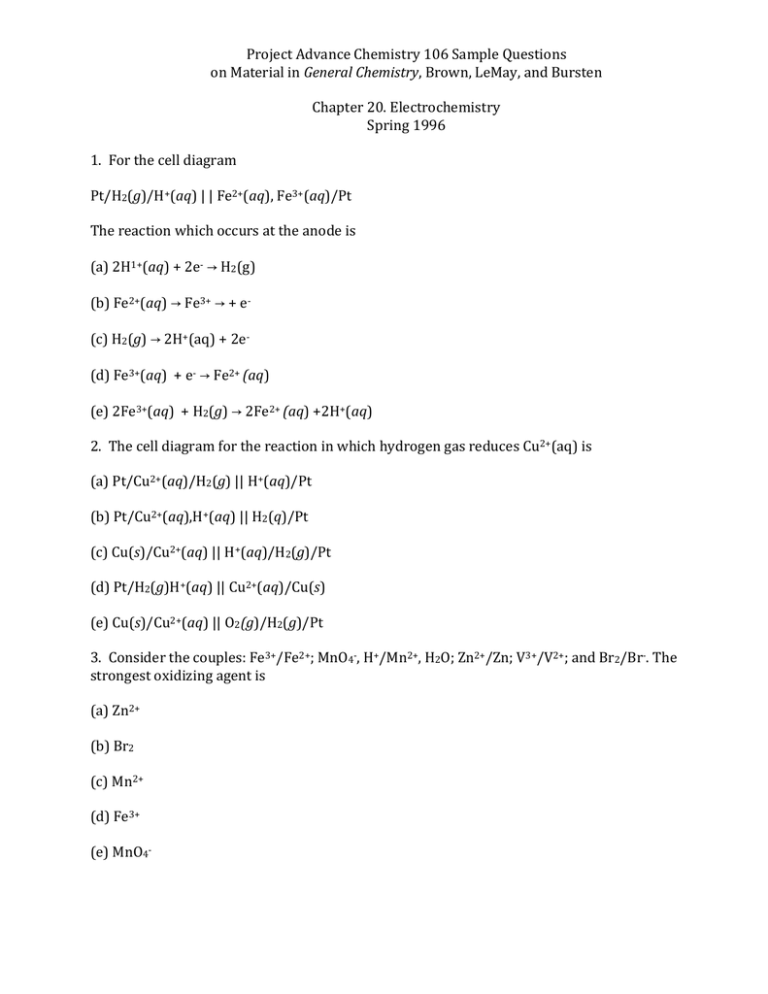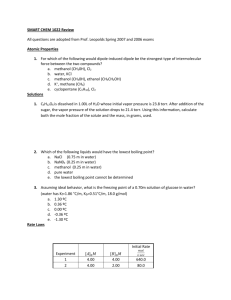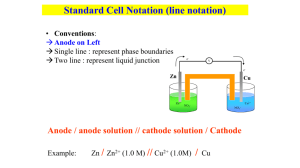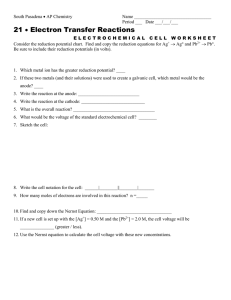20-2
advertisement

Project Advance Chemistry 106 Sample Questions on Material in General Chemistry, Brown, LeMay, and Bursten Chapter 20. Electrochemistry Spring 1996 1. For the cell diagram Pt/H2(g)/H+(aq) | | Fe2+(aq), Fe3+(aq)/Pt The reaction which occurs at the anode is (a) 2H1+(aq) + 2e- → H2(g) (b) Fe2+(aq) → Fe3+ → + e(c) H2(g) → 2H+(aq) + 2e(d) Fe3+(aq) + e- → Fe2+ (aq) (e) 2Fe3+(aq) + H2(g) → 2Fe2+ (aq) +2H+(aq) 2. The cell diagram for the reaction in which hydrogen gas reduces Cu2+(aq) is (a) Pt/Cu2+(aq)/H2(g) || H+(aq)/Pt (b) Pt/Cu2+(aq),H+(aq) || H2(q)/Pt (c) Cu(s)/Cu2+(aq) || H+(aq)/H2(g)/Pt (d) Pt/H2(g)H+(aq) || Cu2+(aq)/Cu(s) (e) Cu(s)/Cu2+(aq) || O2(g)/H2(g)/Pt 3. Consider the couples: Fe3+/Fe2+; MnO4-, H+/Mn2+, H2O; Zn2+/Zn; V3+/V2+; and Br2/Br-. The strongest oxidizing agent is (a) Zn2+ (b) Br2 (c) Mn2+ (d) Fe3+ (e) MnO4- 4. Which pair of metals will dissolve in nitric acid? (a) Pt, Au (b) Pt, Ag (c) Pt, Fe (d) Ag, Fe (e) Ag, Au 5. For the cell Pb(s)/PbSO4(s)/SO42-(aq) || Pb2+(aq)/Pb(s) the overall reaction is (a) SO42-(aq) + H+(aq) → HSO4- (aq) (b) Pb(s) + 2H+(aq) → Pb2+(aq) + H2(g) (c) PbSO4(s) → Pb2+(aq) + SO42- (aq) (d) Pb2+(aq) + SO42- (aq) → PbSO4(s) (e) SO42-(aq) + H2O(l) → HSO4- (aq) + OH-(aq) 6. Determine E° for the cell Zn(s)/Zn2+(aq) || Cl-(aq)/AgCl(s)/Ag(s) (a) 1.56 V (c) 0.54 V (e) 0.98 V (b) -0.54 V (d) 0.04 V 7. The standard potential, E°cell, of the cell Ag(s)/Ag+(aq) || Cl-(aq)/AgCl(s)/Ag(s) is -0.58 V at 25°C. Calculate the equilibrium constant for the cell reaction. [RT/F = 0.02569 V] (a) 6.5 × 109 (b) 1.6 × 10-10 (c) 1.2 × 10-5 (d) 2.3 × 10-20 (e) 2.5 × 10-23 8. Calculate E for the following cell at 25°C in aqueous solution. Pt/Sn2+ (0.40 M), Sn2+(0.10 M) || Sn4+(0.030 M), Sn2+(0.010 M)/Pt For Sn4+ + 2e- → S2+, E° = 0.150 V and RT/F = 0.02569 V. (a) 0.214 V (c) 0.118 V (e) 0.032 V (b) 0.182 V (d) 0 V 9. Magnesium is produced commercially by electrolysis of molten magnesium chloride. The electrolysis produces which products at the anode and the cathode, respectively? (a) O2(aq) and Mg(l) (b) Cl-(aq) and MgO(l) (c) Mg(l) and O2(g) (d) Cl2(g) and MgO(l) (e) Cl2(g) and Mg(l) 10. The products of the electrolysis of NaF(aq) are (a) H2(g), OH-(aq) and F2(g) (b) H2(g) and F2(g) (c) Na(l) and O2(g) (d) Na(l) and F2(g) (e) H2(g) and O2(g) 11. Calculate Ecell for the following cell at 25°C. Ni(s)/Ni2+ (aq,0.200 M) || Cl- (aq,0.200 M)/Cl2(g,0.500 atm)/Pt(s) The E°cell for the reaction is 1.59 V and RT/F = 0.02569 V at 25°C. (a) 1.65 V (b) 1.59 V (c) 1.81 V (d) 1.70 V (e) 1.48 V 12. Calculate the volume of oxygen gas produced at STP by the electrolysis of water by passage of a current of 2.0 amperes for 1 hour. (a) 0.0070 L (b) 5.6 L (c) 0.84 L (d) 1.68 L (e) 0.42 L 13. The two electrodes Cr(s)/Cr3+(aq) and Sn(s)/Sn2+(aq) are combined to afford a spontaneous electrochemical reaction. The standard reduction potentials for the chromium and tin electrodes are -0.74 V and -0.14 V, respectively. The cell voltage, E°cell, in volts is (a) +0.88 (b) -0.88 (c) +0.60 (d) -0.60 (e) +2.50 14. A solution of a certain metal ion, Mn+, [Atomic wt. = 110.0] is electrolyzed using a current of 0.75 A for 30.0 min. If 0.5130 g of the metal are deposited on the cathode, what was the charge, n+, on the metal ion? (a) 1 (b) 2 (c) 3 (d) 4 (e) not enough information to determine the charge on the metal ion? 15. For the electrochemical cell shown below to the right, the cell reaction is 14H+ + Cr2O72- + 3Sn2+ → 3Sn4+ + 2Cr3+ + 7H2O The electrode on the ___________ is the cathode and it has a ___________ sign. (a) right, positive (b) right, negative (c) left, negative (d) left, positive 16. If CaCl2(aq) is electrolyzed using inert electrodes (a) H2(g) is produced at the cathode and Cl2(g) at the anode. (b) Cl2(g) is produced at the cathode and H2(g) at the anode. (c) H2(g) is produced at the cathode and O2(g) at the anode. (d) Ca(s) is produced at the cathode and Cl2 at the anode. (e) Cl2(g) is produced at the cathode and Ca(s) at the anode. 17. If ∆G° = -1268.2 kJ (at 25°C) for the reaction 4Zn(s) + 10H+ + NO3- → 4Zn2+ + NH4++ 3H2O(l) what is E° (to three significant figures)? (a) 6.57 V (b) 1.64 V (c) 0.00657 V (d) 0.00164 V (e) -6.57 V 18. The voltage produced in the reaction Fe(s) + Cu2+(aq) → Cu + Fe2+(aq) is independent of (a) the concentration of Fe2+. (b) the concentration of Cu2+ (c) the metal used as the anode. (d) the size of the anode. (e) the temperature. 19. Which of the following statements is false? (a) Conduction in an electrolyte solution occurs by the movement of ions. (b) In the galvanic cell: Cu2+ Fe → Cu + Fe2+, the mass of the anode decreases as the cell reaction proceeds. (c) The cathode carries a negative charge during electrolysis. (d) In a galvanic cell, the anode is negatively charged. (e) In a galvanic cell, anions move toward the cathode. 20. In an experiment to measure the reduction potential of Ti2+, the galvanic cell shown below was set up. The cell potential was 0.07 V. The zinc electrode was positive and the titanium electrode negative. The E° for Zn2+ is -0.76 V. What is E° for Ti2+? (a) -0.41 V (b) +0.69 V (c) -0.69 V (d) +0.83 (e) -0.83






